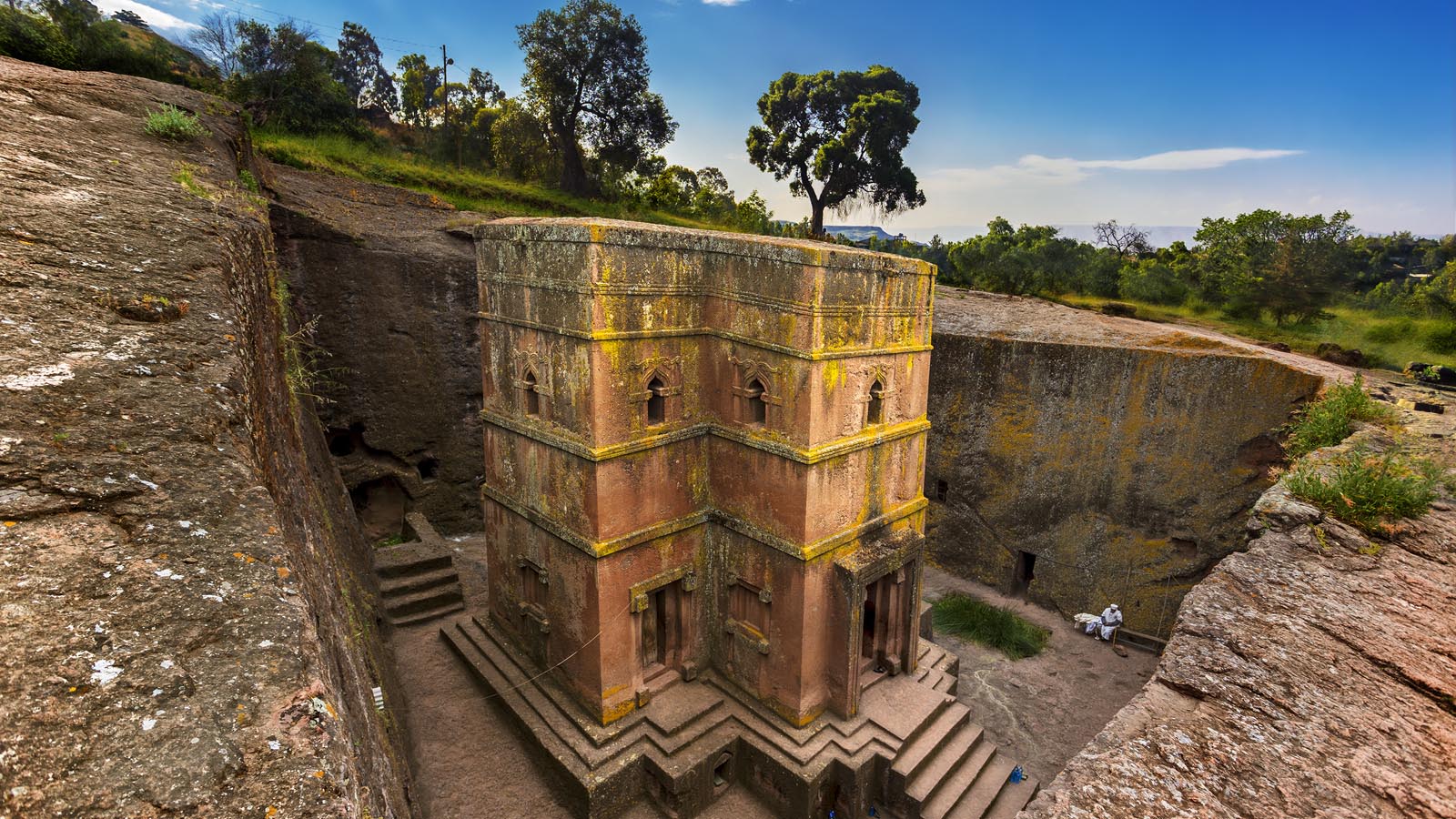Lalibela
Lalibela (Amharic: ላሊበላ) is a town in Lasta Amhara Region, Ethiopia famous for its rock-cut monolithic churches. The whole of Lalibela is a large antiquity of the medieval and post-medieval civilization of Ethiopia. Lalibela is one of Ethiopia’s holiest cities, second only to Axum, and a center of pilgrimage. Unlike Axum, the population of Lalibela is almost completely Ethiopian Orthodox Christian.
Ethiopia was one of the earliest nations to adopt Christianity in the first half of the 4th century, and its historical roots date to the time of the Apostles. The churches themselves date from the 7th to 13th centuries, and are traditionally dated to the reign of the Zagwe king Gebre Mesqel Lalibela (r. ca. 1181–1221).
The layout and names of the major buildings in Lalibela are widely accepted, especially by local clergy, to be a symbolic representation of Jerusalem. This has led some experts to date the current church forms to the years following the capture of Jerusalem in 1187 by the Muslim leader Saladin.
Lalibela is located in the North Wollo Zone of the Amhara Region, at roughly 2,500 metres (8,200 ft) above sea level. It is the main town in Lasta woreda, which was formerly part of Bugna woreda. The Rock-Hewn Churches were declared a World Heritage site in 1978.
-
Included
AccommodationGuideInsuranceMeals -
Not Included
FlightsTransport
Tour Plan
Fly to Lalibela and visit Lalibela rock hewn church
Fly to Gondar visit the castle of Fasil and drive back to Bahir Dar
Tour Location
History of the City
During the reign of Gebre Mesqel Lalibela, a member of the Zagwe dynasty who ruled Ethiopia in the late 12th century and early 13th century, the current town of Lalibela was known as Roha. The saint-king was named because a swarm of bees is said to have surrounded him at his birth, which his mother took as a sign of his future reign as emperor of Ethiopia. The names of several places in the modern town and the general layout of the rock-cut churches themselves are said to mimic names and patterns observed by Lalibela during the time he spent as a youth in Jerusalem and the Holy Land. Lalibela, revered as a saint, is said to have seen Jerusalem, and then attempted to build a new Jerusalem as his capital in response to the capture of old Jerusalem by Muslims in 1187. Each church was carved from a single piece of rock to symbolize spirituality and humility. Christian faith inspires many features with Biblical names – even Lalibela's river is known as the River Jordan. Lalibela remained the capital of Ethiopia from the late 12th into the 13th century. The first European to see these churches was the Portuguese explorer Pêro da Covilhã (1460–1526). Portuguese priest Francisco Álvares (1465–1540), accompanied the Portuguese Ambassador on his visit to Dawit II in the 1520s. He describes the unique church structures as follows: "I weary of writing more about these buildings, because it seems to me that I shall not be believed if I write more... I swear by God, in Whose power I am, that all I have written is the truth[.]". Ethiopian Orthodox priests holding a procession in Lalibela. Although Ramuso included plans of several of these churches in his 1550 printing of Álvares' book, who supplied the drawings remains a mystery. The next reported European visitor to Lalibela was Miguel de Castanhoso, who served as a soldier under Cristóvão da Gama and left Ethiopia in 1544. After de Castanhoso, more than 300 years passed until the next European, Gerhard Rohlfs, visited Lalibela some times between 1865 and 1870. According to the Futuh al-Habaša of Sihab ad-Din Ahmad, Ahmad ibn Ibrahim al-Ghazi burned one of the churches of Lalibela during his invasion of Ethiopia. However, Richard Pankhurst has expressed his skepticism about this event, pointing out that although Sihab ad-Din Ahmad provides a detailed description of a rock-hewn church ("It was carved out of the mountain. Its pillars were likewise cut from the mountain."), only one church is mentioned; Pankhurst adds that "what is special about Lalibela, (as every tourist knows), is that it is the site of eleven or so rock churches, not just one – and they are all within more or less a stone's throw of each other!" Pankhurst also notes that the Royal Chronicles, which mention Ahmad al-Ghazi's laying waste to the district between July and September 1531, are silent about him ravaging the fabled churches of this city. He concludes by stating that had Ahmad al-Ghazi burned a church at Lalibela, it was most likely Biete Medhane Alem; and if the Muslim army was either mistaken or misled by the locals, then the church he set fire to was Gannata Maryam, "10 miles [16 km] east of Lalibela which likewise has a colonnade of pillars cut from the mountain."Tour Review Scores And Score Breakdown



